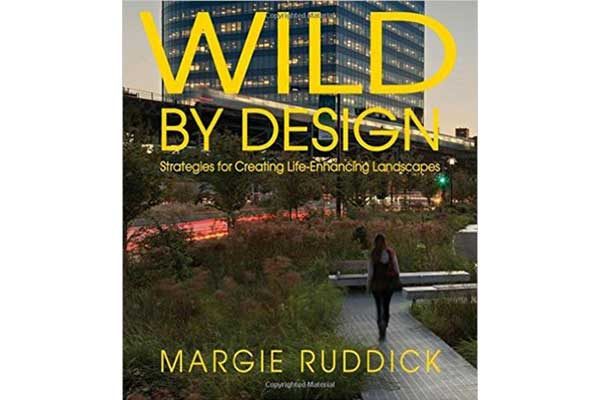
Author: Margie Ruddick (Island Press, 2016)
Wild By Design: Strategies for Creating Life-Enhancing Landscapes recounts the work of Margie Ruddick’s self-named firm over the last 20 years, by sorting a wide range of projects through various lenses of sustainable landscape design. Projects span continents and biomes, from a phased, 10-year masterplan for a 2,500 acre eco-resort in Maharashtra, India, to her own front yard in Pennsylvania.
Told in first person, Ruddick’s entertaining prose is strongest when imparting valuable lessons learned from years of practice through anecdotal storytelling about her own experiments and conversations with clients and collaborators, giving readers a view into the many types of people and projects that pass through a landscape architecture office:
“When I started to plan out the flow of the water through the landscape on the site, the aerial plan started to take on the shape of a fish…The fish-ness had me very worried; after all, I had passed through 3 years of graduate school at Harvard, where the term literal was the kiss of death. Abstraction was the norm; anything representational or figurative – anything that was recognizable as something other than a landscape – was considered unsophisticated. This training led me to feel strikingly out of my comfort zone in the presence of literal representation. So the second week…I tried to make the plan look less like a fish… When the local landscape architects came to work on it, they took one look at the first draft plan pinned up on the wall and said, with a lot of enthusiasm, “Great! It looks like a fish.” They were encouraged because the fish is a sign of good health and good fortune. The fish-ness was an asset… and I must admit that the act of creating a plan so literal felt magnificently liberating.”
– Ruddick, on the design process for the Living Water Park in Chengdu, Sichuan, China
The book is accessible to those who know little to nothing about landscape architecture and what landscape architects actually do, though the conclusions and generalizations about defining sustainability, ecology, and art in practice are not new to those in the profession.
Ruddick clearly comes across as a pioneer in the field of ecological landscape design, and one can trace various movements of formalism to landscape urbanism through the various projects her firm develops over the years. The outstanding narrative in the compilation is undoubtedly her telling of loose strategies for experimentally maintaining and managing a succession of self-seeding plants on her front yard, eventually leading to a summons from the City of Philadelphia for allowing weeds to grow more than 10 inches tall. Beyond being a home grown starter of the wild planting movement, the story illuminates so much about the potency of gardens and landscapes to affect and connect people and natural process.
First, there is the recognition that the landscapes that surround our home shape our sense of place and understanding of their nature. Their ‘wilderness’ stays with us for a lifetime. Second, there are the designs, the intentions, and human hands that shape over many years of selective removal, addition, and mowing, formal patterns to bring order into the landscapes that foreground our everyday lives, but belong to a larger picture. Third, they are sites of social and cultural exchange – neighbours, cultural norms (a mowed lawn), and city bylaws that shape the form and function of patches of earth we deem partly shared, and partly ours.
Ruddick’s favourite mantra “what are we doing here, anyways?” – the original working title for the book – serves as a gentle reminder to continually challenge our learned ways of thinking and doing in design practice.
***
If you want more information on Wild By Design, visit the Island Press website.
**
Shelley Long is a landscape designer interested in cross-disciplinary collaboration in environmental design, Canadiana, and place-making through space-making.


